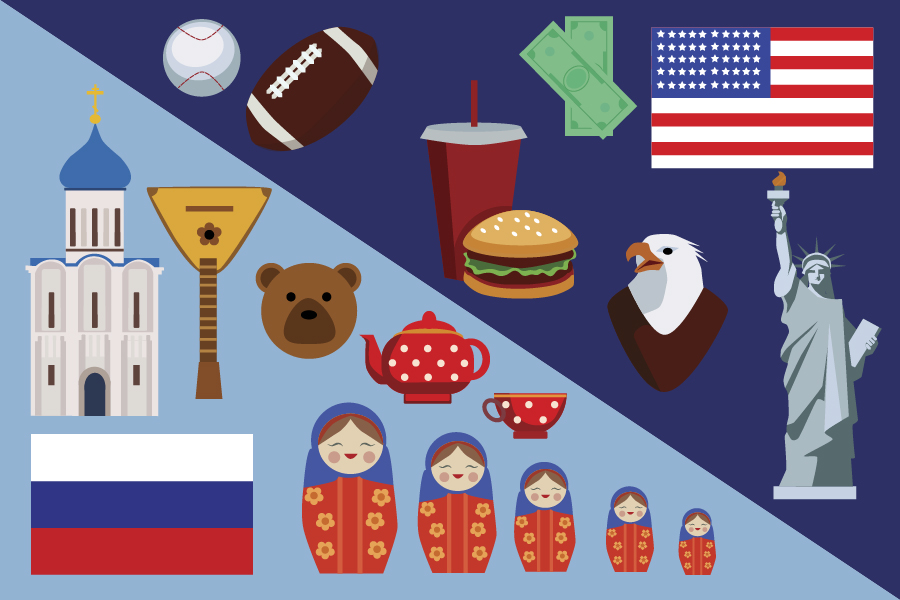
A relationship that requires a deeper cultural view
 It’s a common thread in travel writing: how we can learn about American society by immersing ourselves in a foreign culture. The relationship between Russia and America is obviously fraying, if not completely fried, so the complex web of cultural differences needs to be uncovered and hopefully appreciated if things are to improve. This is a country clearly distinct from America, and more observations of the society that created Tolstoy, Lenin and Putin should fine-tune my understanding of what makes Russia tick — and hopefully yours. Here’s what I’ve learned so far.
It’s a common thread in travel writing: how we can learn about American society by immersing ourselves in a foreign culture. The relationship between Russia and America is obviously fraying, if not completely fried, so the complex web of cultural differences needs to be uncovered and hopefully appreciated if things are to improve. This is a country clearly distinct from America, and more observations of the society that created Tolstoy, Lenin and Putin should fine-tune my understanding of what makes Russia tick — and hopefully yours. Here’s what I’ve learned so far.
The cold is real
Ah yes, the notorious cold. And while I haven’t yet traveled to Siberia, the literary and pop-cultural buzzword for “coldest place on Earth where nobody wants to go,” St. Petersburg is still frigid — temperatures with wind chill can hit the negative teens — compared to the relatively mild winters of the American West Coast. The city’s proximity to the Gulf of Finland moderates the temperatures a little, meaning Moscow is usually colder despite being farther south. But wind and high humidity ensure the icy air will be felt down to the core of your bones.
One of the chief complaints among the Russians I know is the weather. They don’t like it one bit. And it seems to affect them just as much as the Americans who usually wear shorts starting mid-March (re: this guy). It’s not recommended to forget your hat — I’ve been reprimanded by multiple babushkas for doing just that, showing just how much Russians respect the cold.
Good fashion is mandatory
If you want to experience the pinnacle of fashion and you can hurdle the tricky visa process, come to St. Petersburg. Sweatpants don’t seem to exist. Gym attire reflects the flashy, bare-skinned look of fitness gurus who implore us to buy the latest ab-shredder in the U.S. There are very few university students who walk around in beat-up jeans. Middle-aged women are often decked out in fur coats and high-heeled boots, carrying handbags with fancy labels.
Preserving the latest fashion even in the bitter cold makes this all the more impressive. The past few weeks have seen temperatures drop to zero or below, with the pavement caked in slippery ice and snow that make walking and maintaining dignity difficult — and still, the average Russian looks good while doing it.
Americans are loud — and obvious
There appears to be a stark difference between what I call the “culture of public interaction” in the U.S. and in Russia. I’ve alluded to this before, and the observation still holds — smiling at strangers on the street is weird. Crowded metro-speak is not speaking at all, but more of a stoic eye-lock or grunt that lets people know you need to leave at the next station. It is, of course, a generalization, and there are plenty of (mostly) younger Russians I know who will exude a toothier and more audible existence in public, but that isn’t the norm.
And we know the mirrored stereotype of Americans — that they are loud, generally obnoxious and like to smile. This is largely true. We are much louder than native Russians. We tend to smile at random people more and have to suppress this urge when we don’t want to draw attention. American students’ tendency to travel in large and rather conspicuous packs sets us immediately apart from the Russians around us. We may as well be fully enshrouded in American flags, carrying boomboxes pumping out our national anthem.
PC culture feels very, very American
Please don’t shoot the messenger — the PC culture so prevalent in America is almost nonexistent in Russia, and it’s rather refreshing. In the States, there exists a tendency to label and shut down viewpoints that offend certain sensibilities. (I’m aware the Russian government has its own tendency to shut down certain viewpoints and political opponents, but it does so for reasons of self-preservation, not out of perceived hurt feelings.)
American PC culture requires walking on eggshells to avoid one of the notorious “isms” thrown around the debating table. The popularity of combatting so-called “microaggressions” on college campuses, as just one example, can distract from larger — and more important — issues, such as the epidemic of gun violence.
The people I’ve talked to and the popular culture I’ve seen in St. Petersburg, by contrast, focus on larger topics of discussion. Relations with America, the economy and the upcoming presidential elections are more pertinent than the types of offendable actions that are indicted by young people in the U.S. But even more important than these topics is daily life itself — long commutes, extreme cold and bantering with friends take priority over some of the squabbles making headlines at American colleges.
I’ve noted only some of the most obvious points of inter-cultural interest. There are many more. If we are to make progress mending the rift between two historically relevant nations, we need to adopt an open mindset that allows cultural difference to flourish and cooperate. Is that not what liberalism is all about?
Written by: Nick Irvin — ntirvin@ucdavis.edu
Disclaimer: The views and opinions expressed by individual columnists belong to the columnists alone and do not necessarily indicate the views and opinions held by The California Aggie.



